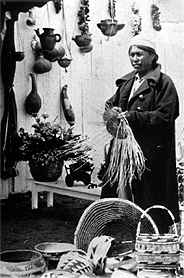Yurok
The Yurok are West Coast Indians who lived in northern California on the lower Klamath River and the Pacific coast. They traditionally speak Yurok , a language from the Algerian language family . The name comes from the neighboring Karok and means downstream . Today they live in a reservation that is located at the mouth of the Klamath River in their former residential area.
Culture
Yurok villages were small; a village was more like a collection of independent houses inhabited by individual families than a closed community with a political leadership. The villagers sometimes shared the rights to use subsistence areas and to perform various rituals ; however the rights for fishing, hunting and gathering were generally given to specific houses. These rights could be acquired through inheritance, dowry, blood money, and purchase. Next to the residential buildings there were the sweat lodges , in which men of the social base unit slept; these were male relatives of the paternal side, who were headed by the oldest member. There were also small separate menstrual huts for women in the village .
The yurok, whose livelihoods were salmon and acorns, made excellent basketry and canoes from redwood trees, which they sold to the local tribes. Prosperity came from owning strings made from Dentalium shells, obsidian blades, woodpecker scalps, and albino deer skins. The Yurok's pursuit was wealth. Often there were disputes that ended with paying blood money, the amount of which was set on a precise scale according to the importance of the offense. The value of a human life depended on its social status.
religion
Religion manifested itself in personal efforts to obtain supernatural help, particularly through ritual cleansing, and in rituals for public welfare. The main ceremony of the Yurok was the World Renewal Cycle, the goals of which were adequate food, prosperity and general wellbeing. The ceremony included the recitation of magical formulas repeating the words of an ancient spiritist race and various other actions. The spiritual power to heal illnesses was limited to women, which enabled them to gain prestige and wealth.
There were two types of medicine men , the Kegeyowor - who acted as healers - and the Weskweloy - who could also be warriors. Both mastered ritual trance techniques , the acquisition of which they traced back to supernatural spirits ( however, they were not familiar with an ecstatic soul journey as with the Siberian shamans ).
The Yurok had no potlatch or mask dances, nor were there any special arts or other characteristics that were typical of most cultures of the Northwest.
Reconstructed Yurok House in Redwood National Park
history

During the North American gold rush of the mid- 19th century , the Californian Indians were brutally suppressed and the Yurok were no exception. According to most reports, the Yurok were a quiet and undemanding people and had little conflict with the prospectors. The state, however, paid a $ 5 reward for the head of a male Indian, and the white headhunters made no distinction between a Karok warrior and a peaceful Yurok fisherman. All of California's Native Americans suffered from the same problem - more than 90 percent of the Native American population was killed during the 19th century.
Today there are about 3,500 Yurok in northern California. Sometimes they mixed with the neighboring Wiyot.
language
The Yurok language is distantly related to the neighboring Wiyot language . Today it is assumed that both languages developed from one and the same original language. The number of native speakers was around 10 in 2002, making this language one of the critically endangered.
See also
literature
- Robert F. Heizer (Ed.): Handbook of North American Indians . Vol. 8: California, Smithsonian Institution Press, Washington DC 1978, ISBN 0-16004-574-6 .
- Alfred Kroeber : Yurok Myths. University of California Press, Berkeley 1978, ISBN 0-5200-2977-1 .
Web links
- Official website of the Yurok Tribe (English)
- Yurok language (English)
- Website of UCB for field investigation of the Yurok language (English).
Individual evidence
- ↑ Christian F. Feest : Animated Worlds - The religions of the Indians of North America. In: Small Library of Religions , Vol. 9, Herder, Freiburg / Basel / Vienna 1998, ISBN 3-451-23849-7 . P. 139.
- ↑ http://www.ethnologue.com/show_language.asp?code=yur






